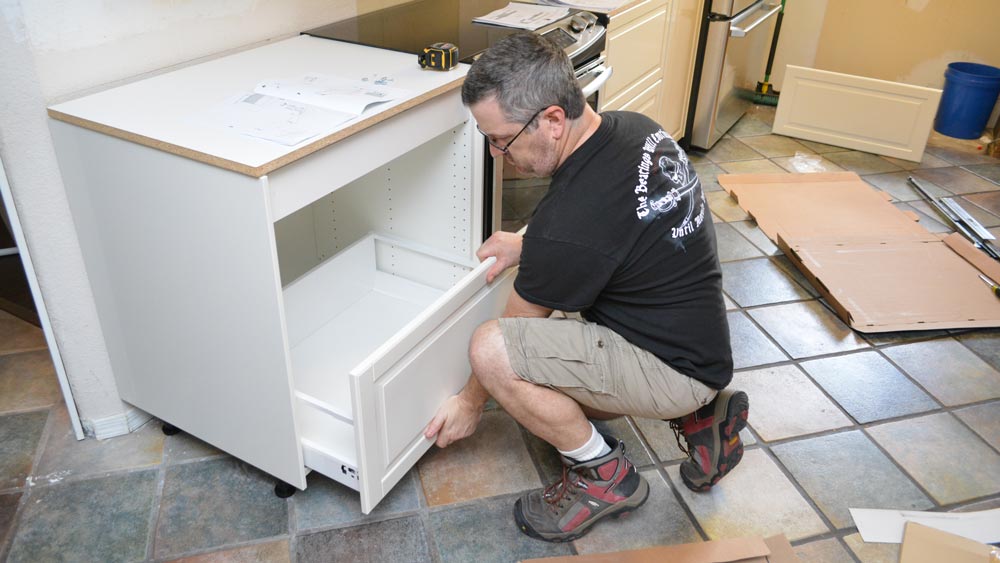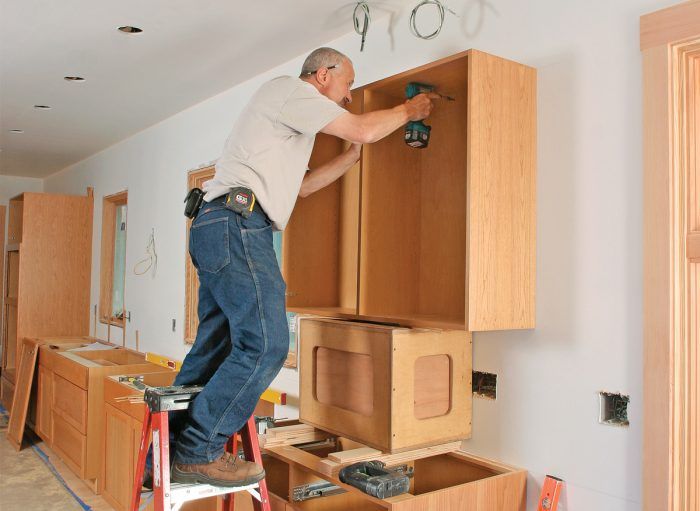Planning & Preparation
Adding cabinets to an existing kitchen can significantly enhance storage space and improve functionality. However, careful planning and preparation are crucial for a successful outcome.
Assessing Existing Kitchen Space
Before embarking on any cabinet installation, a thorough assessment of the existing kitchen space is essential. This involves identifying potential challenges and opportunities for optimization.
- Measuring Existing Space: Accurately measuring the available space is fundamental. This includes measuring the width, depth, and height of the existing cabinets, countertops, appliances, and any other obstructions. Accurate measurements will prevent potential problems during installation.
- Identifying Obstacles: Obstacles such as plumbing, electrical wiring, and ventilation systems need to be carefully considered. These elements can influence the location and design of new cabinets.
- Assessing Existing Cabinetry: If the existing cabinets are in good condition, consider incorporating them into the new design. This can help save costs and enhance the overall aesthetic appeal.
- Evaluating Lighting and Ventilation: Proper lighting and ventilation are essential for a functional kitchen. Assess the existing lighting and ventilation systems and determine if modifications are necessary to accommodate the new cabinets.
Planning Cabinet Layout
Planning the layout of new cabinets involves maximizing storage space and functionality while ensuring aesthetic appeal.
- Defining Storage Needs: Determine the types of items you need to store and their respective sizes. This will help you plan the size and configuration of the new cabinets.
- Creating a Layout Plan: Draw a scaled plan of the existing kitchen space and experiment with different cabinet layouts. Consider the placement of appliances, countertops, and walkways.
- Choosing Cabinet Styles: Select cabinet styles that complement the existing kitchen design and meet your storage needs. Consider the material, finish, and features of the cabinets.
- Optimizing Functionality: Incorporate features like pull-out drawers, spice racks, and lazy Susans to maximize functionality and make it easier to access stored items.
Cabinet Selection & Installation

Selecting and installing new cabinets is a crucial step in your kitchen renovation project. This section will explore the different types of cabinets available, the advantages and disadvantages of custom versus pre-fabricated options, and provide a comprehensive guide to installing your new cabinets.
Types of Cabinets
Cabinet types vary significantly in terms of materials, styles, and finishes. Here’s a breakdown of common options:
- Wood Cabinets: These are the most popular choice due to their durability, beauty, and versatility. They can be made from various hardwoods, such as oak, cherry, maple, and walnut, each offering unique grain patterns and colors.
- Laminate Cabinets: These cabinets are made with a core of particleboard or plywood covered with a durable laminate finish. They are more affordable than wood cabinets and offer a wide range of colors and patterns.
- Thermofoil Cabinets: These cabinets have a core of plywood or particleboard covered with a vinyl film that is heat-sealed to the surface. They are resistant to moisture and scratches, making them a good choice for kitchens with high traffic.
- Painted Cabinets: These cabinets are made from wood or other materials and then painted with a high-quality enamel paint. They offer a wide range of color options and can be customized to match your kitchen’s décor.
- Glass-Front Cabinets: These cabinets feature glass doors, allowing you to showcase your beautiful dishes, glassware, or decorative items. They are often used for upper cabinets or display shelves.
Custom vs. Pre-fabricated Cabinets
The decision between custom and pre-fabricated cabinets depends on your budget, design preferences, and timeline.
- Custom Cabinets: These are designed and built to your exact specifications, allowing for unique designs, specialized features, and perfect fit for your kitchen. They are typically more expensive than pre-fabricated cabinets but offer greater flexibility and customization.
- Pre-fabricated Cabinets: These are mass-produced in standard sizes and designs, making them more affordable than custom cabinets. They are readily available and can be installed quickly, but may require some modifications to fit your kitchen perfectly.
Cabinet Costs
Cabinet costs vary depending on materials, style, size, and complexity. Here’s a table outlining approximate costs for different cabinet options:
| Cabinet Type | Average Cost per Linear Foot |
|---|---|
| Wood Cabinets (Standard) | $200 – $500 |
| Wood Cabinets (High-End) | $500 – $1000+ |
| Laminate Cabinets | $100 – $250 |
| Thermofoil Cabinets | $150 – $350 |
| Painted Cabinets | $200 – $450 |
| Glass-Front Cabinets | $250 – $600 |
Cabinet Installation
Installing new cabinets requires careful planning, proper tools, and attention to safety. Here’s a comprehensive guide to installing your cabinets:
- Tools and Materials: You’ll need a variety of tools for cabinet installation, including a stud finder, level, tape measure, drill, screwdriver, saw, hammer, and safety glasses. You’ll also need screws, anchors, and shims.
- Preparing the Walls: Ensure the walls are smooth, level, and free of any obstacles. Use a stud finder to locate wall studs and mark them for support.
- Installing Lower Cabinets: Start by installing the lower cabinets. Align them carefully using a level, and secure them to the wall studs with screws. Use shims to adjust for uneven floors.
- Installing Upper Cabinets: Install the upper cabinets after the lower cabinets are in place. Measure the distance between the lower cabinets and the ceiling to determine the height of the upper cabinets. Use a level to ensure the upper cabinets are aligned with the lower cabinets.
- Installing Shelves and Drawers: Once the cabinets are installed, you can add shelves and drawers. Follow the manufacturer’s instructions for installation.
- Finishing Touches: After all the cabinets are installed, you can add trim, molding, and hardware to complete the look.
- Safety Precautions: Always wear safety glasses and gloves when working with tools. Use a ladder or step stool to reach high areas. Be careful when lifting heavy cabinets, and ask for help if needed.
Finishing Touches & Design Considerations: Adding Cabinets To Existing Kitchen

Adding cabinets to your existing kitchen is an excellent way to enhance storage and functionality. However, it’s crucial to ensure the new cabinets seamlessly integrate with the existing kitchen design. This section will discuss important design considerations to create a cohesive and aesthetically pleasing space.
Countertop Materials
The countertop is a prominent feature in any kitchen, and its selection plays a vital role in the overall design. Countertop materials should complement the style of the new cabinets and the existing kitchen design. Here are some popular countertop options:
- Granite: A durable and elegant option with a wide range of colors and patterns. It requires regular sealing to maintain its shine and resist stains.
- Quartz: A non-porous, engineered stone that is highly resistant to scratches, stains, and heat. It comes in various colors and patterns, mimicking natural stone.
- Laminate: An affordable and versatile option available in numerous styles and colors. It is durable but can be prone to scratches and heat damage.
- Butcher Block: A warm and natural option made from wood. It is durable and can be refinished over time. However, it requires regular maintenance and is susceptible to scratches and water damage.
Backsplash Tiles
The backsplash area behind the countertop offers a fantastic opportunity to add visual interest and personality to the kitchen. Selecting backsplash tiles that complement the new cabinets and countertop is essential. Here are some tips for choosing the right backsplash tiles:
- Match the Style: Choose tiles that complement the style of the cabinets and countertop. For example, subway tiles work well with traditional and modern kitchens, while patterned tiles add a touch of personality.
- Consider Color: Choose tile colors that complement the existing kitchen color scheme or create a contrasting accent wall. Neutral colors like white or gray offer a timeless look, while bold colors add a pop of energy.
- Think about Texture: Tiles come in various textures, from smooth to textured. Textured tiles add depth and dimension to the backsplash, while smooth tiles create a sleek and modern look.
Hardware
Cabinet hardware, such as knobs and pulls, plays a significant role in the overall aesthetic of the kitchen. Selecting hardware that complements the new cabinets and the existing kitchen design is crucial. Here are some factors to consider:
- Style: Choose hardware that complements the style of the cabinets. For example, modern kitchens often feature minimalist hardware, while traditional kitchens might use ornate knobs and pulls.
- Finish: The finish of the hardware should complement the other metal finishes in the kitchen, such as faucets and lighting fixtures. Popular finishes include brushed nickel, oil-rubbed bronze, and polished chrome.
- Size: Consider the size of the cabinets and the overall scale of the kitchen when choosing hardware. Large knobs and pulls work well with larger cabinets, while smaller hardware is better suited for smaller cabinets.
Lighting, Adding cabinets to existing kitchen
Lighting plays a crucial role in creating a functional and inviting kitchen. Proper lighting can enhance the look and functionality of the space, highlighting the new cabinets and the existing kitchen design. Here are some lighting considerations:
- Task Lighting: Install task lighting under cabinets to provide focused illumination for food preparation and cleaning. This is essential for ensuring adequate visibility on countertops and workspaces.
- Ambient Lighting: Use ambient lighting, such as a pendant light or chandelier, to create a warm and inviting atmosphere in the kitchen. Consider using dimmable bulbs to adjust the lighting level for different activities.
- Accent Lighting: Highlight specific features of the kitchen, such as the new cabinets or artwork, with accent lighting. This can add visual interest and create a focal point.
Adding cabinets to existing kitchen – Adding cabinets to an existing kitchen can be a great way to maximize storage and create a more functional space. If you’re looking for a classic and timeless style, consider incorporating beveled shaker cabinet doors. Their simple design and subtle beveling add a touch of elegance and sophistication, seamlessly blending with any kitchen aesthetic.
With their versatility and timeless appeal, beveled shaker cabinet doors can help you achieve a cohesive and functional kitchen that reflects your personal style.
Adding cabinets to your existing kitchen can be a great way to increase storage space and improve functionality. If you’re looking for a modern and stylish option, consider contemporary maple kitchen cabinets. Their clean lines and warm wood tones will instantly elevate your kitchen’s aesthetic, while providing ample storage solutions for all your culinary needs.

